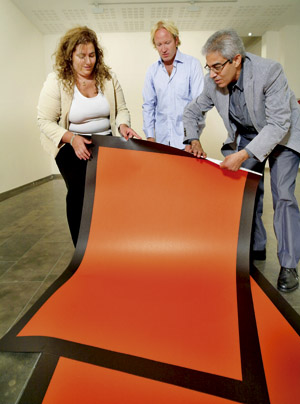(THIS ARTICLE IS MACHINE TRANSLATED by Google from Norwegian)
Four years ago, a Norwegian artist woke up with a wild idea. The artist was Henrik Placht. In his time, he was saved from an uncertain future in the interior of Groruddalen, "a place that had a lot of fellowship and baptism" when he entered the Oslo Academy of the Arts (KHIO). If you are saved, it is fair and reasonable that you save others, Henrik thought, and called the Foreign Ministry.
- Hi, I have a wild idea, he said.
- I would like to start an art academy in Ramallah.
The Ministry of Foreign Affairs was on the notes and provided funding.
Four years later, two Palestinians visit Oslo to sign a letter of intent with KHIO. Mazan Qupty is a lawyer and chair of the Palestinian Association of Contemporary Art (Paca), and believes the art academy that started with Placht's idea is the biggest thing that has happened to Palestinian art in a long time.
- This will be extremely important for Palestine, and will shape our culture for a long time to come. Come and visit in 20 years, and you will see a flourishing Palestinian art scene. If you look, you will also see the influence of KHIO and Norwegian contemporary art.
Coveted students
Although the initiative is Plachts, the money is Norwegian and the collaboration with KHIO is close, all parties emphasize that the academy should be built on Arabic reading. Most of the staff will be local, and the roots will be firmly rooted in Arab tradition and culture.
- Tension between cultures is a good thing in art. The most exciting thing about Palestinian art is that the Palestinian diaspora lives all over the world, and is influenced by the culture where they are – while not forgetting where they come from, says Qupty.
Qupty, who is also Palestine's largest art collector, shows Ny Tid a print by a Palestinian living in Japan, undoubtedly inspired by both cultures. Placht also believes that the difficult everyday life many of the artists in the area live in can force talent.
- In the West, art is often about art, or about art criticism. In Palestine, there is much more substance in the discussions. The students have a more narrative attitude to art, and they use complicated political codes that are not always easy to understand from the outside.
Already in progress
Reem Fadda is the curator and director of Paca, and emphasizes that the project has already borne fruit. For two and a half years, the organization and its Norwegian partners have run workshops in Ramallah. The response has been huge.
- We have lawyers or architects who have dropped out of their careers; those who have pursued art but never received an education; and those who are just young and interested.
The number of applications is doubled each time the workshops are organized, and despite the fact that there are talks of a few weeks, the results have not waited.
- More than half of those who went through the workshop in October last year have been offered a place on a bachelor's or master's program at universities in France, Great Britain and Norway. We have also had solo exhibitions, including in New York, so there is little doubt that the talent is there.
Placht hopes the artists who are cultivated will do much of it internationally, helping to create a more nuanced image of an area many primarily associate with PLO or Hamas.
- Their art history is actually much older and much richer than the Norwegian. It is full of talent, but they have not had professional guidance or a meeting place, Placht believes.
Fadda believes war must never stop art production.
- While the media dehumanizes the war, the artists give the suffering a human face. Art is not only important in war, it is mandatory!
Contemporary art is also a good way to address social and political taboos, because it goes under the radar more easily. Two artists recently printed a work in the form of a questionnaire in a government-friendly Palestinian newspaper, asking questions whether the reader thought there had been a mistake in Palestine's history. The same newspaper would hardly have printed an article or post with the same question.
- A young girl made an installation, Fruitless Pleasures, a box with a curtain, where you can witness an internet chat between two young people and lovers in Palestine inside. You get an insight into their everyday lives and frustrations, such as not being able to meet due to roadblocks and curfews.
Paca has more ambitions than establishing the region's first higher-level Arab art education. In order to help strengthen the Palestinian cultural identity, they hope to also start a Palestinian Museum of Contemporary Art in Jerusalem.
Qupty has donated their collection, and in Oslo they have had talks with the director of the Astrup Fearnley Museum, Gunnar Kvarme, and the National Museum's Sune Nordgren. Both are positive for collaboration, and the prospect of seeing a Yoko Ono or Jeff Koons in Palestine is now greater than ever.
ALESTINIAN ARTS ACADEMY
- Officially launched this fall, but have already run workshops for two and a half years.
- The first litter for undergraduate education will be taken in the fall of 2007.
- The initiator is the Norwegian visual artist Henrik Placht.
- Officially run as an Arab subdivision of the Oslo Academy of the Arts (KHIO) until the school gets its own approval by the Palestinian Authority.
- The Ministry of Foreign Affairs has supported the start-up with NOK XNUMX million. The Ministry of Foreign Affairs has also participated in the academic part of the project.
- Palestinian students are already studying at KHIO as part of the project.


